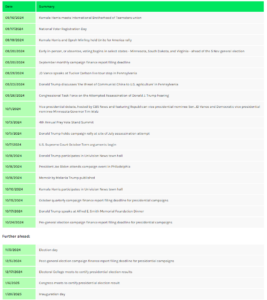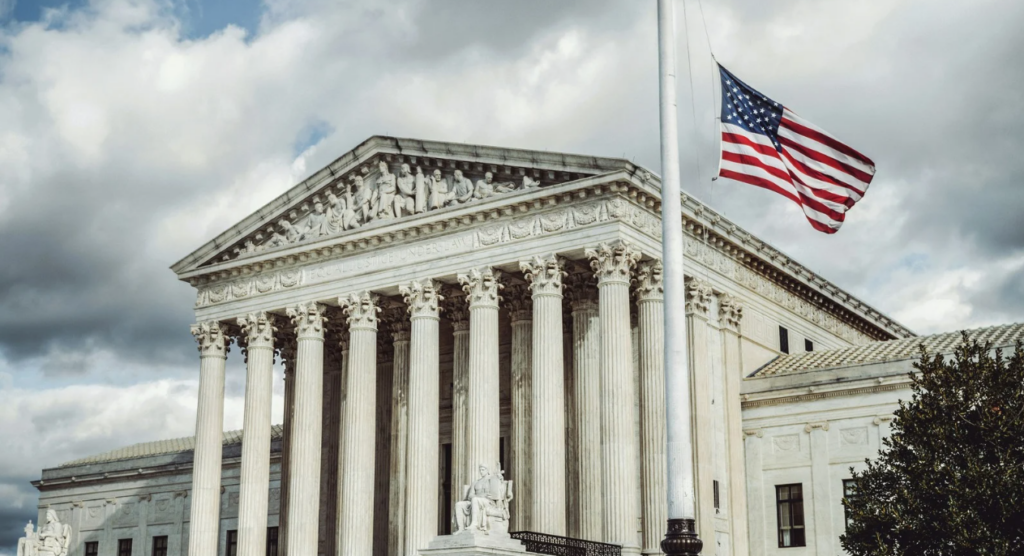Dates covered in this report: July 15, 2024 to September 23, 2024
In the last reporting period the presidential election saw a significant strategy change by the Democratic party on the heels of the first assassination attempt on former president Donald Trump. President Biden stepped down and endorsed Vice President Kamala Harris as the Democrats top pick.
This time period has been a pivotal stretch in the lead-up to the 2024 US presidential election. Both major parties and their candidates have been actively strategizing and positioning themselves to capture voter attention and support, while addressing critical issues facing the country.
Kamala Harris as the Democratic Presidential Candidate: A Historic and Symbolic Candidacy
Kamala Harris’s elevation as the Democratic Party’s presidential candidate marks a historic milestone in U.S. political history. As the first Black woman and first person of South Asian descent to be nominated by a major party, her candidacy symbolizes the growing diversity within the Democratic Party and the broader American electorate. For many, her presence on the ticket represents a breakthrough moment in the fight for representation and inclusion in politics.
Harris’s personal story is central to her political identity. Born to immigrant parents—her mother from India and her father from Jamaica—Harris has often spoken about her upbringing and how it shaped her views on justice, equality, and opportunity.
Harris has positioned herself as a champion of civil rights, criminal justice reform, and social equality.
On the policy front, Harris has staked out positions that appeal to a wide range of Democratic voters. She has been a vocal advocate for reproductive rights, particularly in the wake of the Supreme Court’s decision to overturn Roe v. Wade, and has championed progressive policies on healthcare, climate change, and immigration reform. Harris’s candidacy is also seen as a continuation of President Joe Biden’s agenda, which includes major investments in infrastructure, combating climate change, and expanding access to healthcare.
However, Harris faces challenges as the party’s nominee. Progressives have at times questioned her commitment to more transformative policies, while conservatives have attacked her record as too liberal, particularly on issues like crime and immigration. Navigating these criticisms while defining her own vision for the presidency will be a critical task for Harris as she moves forward in the race.
Trump’s Shift in Strategy: Targeting Harris and Reframing the Election
Former President Donald Trump has built his political brand on countering Democratic candidates, and with Kamala Harris as the Democratic standard-bearer, Trump has adjusted his tactics to address her candidacy directly. Trump’s campaign in 2020 relied heavily on attacking Joe Biden, framing him as a weak leader and a symbol of establishment politics. However, with Harris at the top of the ticket, Trump has shifted his focus to exploit perceived vulnerabilities in her political background and campaign platform, while continuing to rally his base with his hallmark populist message.
One of Trump’s primary tactics has been to paint Harris as a radical leftist, an extension of a broader Republican strategy aimed at labeling the Democratic Party as being out of touch with mainstream America. Trump’s campaign has emphasized Harris’s progressive stances on issues like criminal justice reform and healthcare, often distorting her record to suggest that she supports extreme policies such as defunding the police and open borders. This line of attack is aimed at moderates and suburban voters, who could be swayed by concerns about public safety and immigration enforcement—key issues for many voters, particularly in swing states.
Trump has also sought to portray Harris as inexperienced and unqualified for the presidency. Throughout his rallies and media appearances, Trump has repeatedly questioned Harris’s readiness to lead, pointing to moments in her political career that have drawn criticism, such as her handling of criminal justice issues as California’s attorney general. This critique dovetails with Trump’s broader message about the Biden administration, which he has characterized as incompetent and ineffective. By casting Harris as a continuation of what he portrays as failed leadership, Trump is hoping to sway voters who may have reservations about Biden but are still undecided about Harris.
In addition to his attacks on Harris’s record, Trump has also made an effort to contrast himself with Harris on issues like economic management and foreign policy. Trump’s campaign has focused heavily on the economy, presenting his time in office as a period of economic growth and prosperity, while blaming the Biden administration—and by extension, Harris—for inflation, rising interest rates, and high energy costs. By framing the election as a referendum on economic performance, Trump aims to appeal to voters who may be disillusioned by the current state of the economy but are hesitant to embrace Harris’s progressive economic agenda.
Harris’s Counter to Trump’s Strategy: A Unified Democratic Front
Kamala Harris and the Democratic Party have anticipated many of Trump’s lines of attack and have been preparing a counter-strategy designed to neutralize his criticisms while rallying their base. Harris has sought to frame Trump’s rhetoric as part of a broader pattern of divisiveness and fear mongering, contrasting it with her own message of unity and progress.
In response to Trump’s economic critiques, Harris has highlighted the Biden administration’s achievements, such as job creation, infrastructure investments, and reducing the unemployment rate, while calling for further reforms to address income inequality and climate change.
Harris’s campaign has also focused on voter mobilization efforts, particularly among the key demographic groups that Trump is targeting. Recognizing that suburban women, young voters, and minority communities will be crucial to her success, Harris has leaned into her identity as a woman of color and her commitment to progressive values. She has made reproductive rights, climate action, and criminal justice reform central themes of her campaign, aiming to energize voters who may be concerned about Trump’s policies and rhetoric.
A Defining Race for Both Candidates
The 2024 presidential race between Kamala Harris and Donald Trump presents a defining moment for both candidates and the United States. Harris’s historic candidacy as the first woman of color to lead a major party ticket brings with it opportunities to reshape American politics and energize key voter groups.
However, Trump’s recalibrated strategy shows that he is prepared to fight hard, using a mix of attacks on her policy positions, her readiness to lead, and identity-based appeals to his base.
As the race continues, it will be crucial to see how both candidates adapt their strategies in response to an evolving political landscape. For Harris, the challenge will be to define her own vision for the presidency and connect with voters across a wide ideological spectrum.
For Trump, the task will be to sustain his base while making inroads with moderate and swing voters, particularly in the face of Harris’s unique appeal.
Ultimately, the outcome of this race will have far-reaching implications for the future of American politics and governance.

In this social media report, we analyze Q3 conversations over the period July 15-September 23. During the specified period, we notice a strong increase in conversations around both candidates, with a sharp acceleration on July 21, when Biden stepped down and VP Kamal Harris was endorsed for the top of the Democratic ticket.
Conversations about two parties increased only slightly: because there was less talk of the parties themselves than of actual candidates; still there was a high level of discussion due to the Republican and Democratic national conventions in July and August respectively.
Both events were dwarfed by the Trump assassination attempt on July 13, with a record number of mentions, and to a lesser extent, by Kamal Harris’ entry into the race on July 21.
Conversations about Kamala Harris are primarily focused on campaign issues (abortion, border control, small businesses, the economy, fundamental rights, social security) and crowd enthusiasm at her rallies.
Conversations about Donald Trump were focused on polemics (Arlington Cemetery, Harris’ racial identity, crowd size, fake news). The false Springfield rumor dominated all of Trump’s messages from September 10-15, and generating negative impacts in terms of public disorder.

The topics that grew the most in terms of share of voice on compared to Q2 2024 are Trump’s Project 2025 (+92%), one of Harris’s major opposition topics to criticize Trump, Border Control and Immigration (mainly focused on the Springfield migrant rumor), Federal Workforce (Harris defends civil servant protections as integral to the government’s ability to properly function, as Trump wants to reimpose an executive order that would make it easier to fire certain career civil servants.)

The three main peaks of conversations in Q3 24 focus:
- July 13: the attempted assassination of Donald Trump at the rally in Butler, Pennsylvania, significantly increased mentions of the election on social media over 3 days, producing a peak unseen since the start of the campaign.
- July 21: Joe Biden announces he’s dropping out of the Presidential race and officially endorses Kamala Harris to become the Democratic Presidential candidate.
- September 10: The Presidential debate demonstrated a composed Kamala Harris dominating the discussion while Donald Trump avoided answering direct questions and shared erroneous information as facts. Most polls show Harris winning this debate.
3 other topics also boosted conversations on social media:
- A second assassination attempt on Trump while golfing on one of his courses in Florida.
- Trump’s questioning of Kamala Harris’s racial identity.
- Crowd enthusiasm at the DNC in Chicago.


The timeline of conversations is dominated by Joe Biden’s withdrawal from the presidential race and the endorsement of his VP Kamala Harris. But the highest peak by far concerns the September 10 presidential debate on ABC News, during which VP Harris managed to destabilize Trump on many topics including his ongoing criminal cases and trials, the economy, healthcare, immigration and above all abortion rights. However, it was Trump’s fake news about Haitian immigrants in Springfield, Ohio, that finally got people talking, like Kamala Harris’s incredulous reaction.
Harris now surpasses Trump in the number of mentions on social media. His various speeches are the subject of positive comments on social media by his supporters.
The contrast with Harris is stark, with positive comments on her September 10 TV debate, but also on her various appearances at the DNC in Chicago and at rallies in Atlanta and Detroit. This applies to both form and content. Thus, the most commented facts concern the size of the crowds at her rallies, her stance on abortion rights, the success of her record-breaking fund-raisers (in July after her endorsement, in September after the debate).
Tim Walz also benefits Kamala Harris in terms of popularity and volume of mentions on social media: his appointment as VP running mate on August 6 and his speech at the DNC’s August 21 event both had a positive impact on mentions of Kamala Harris.

This quarter is impacted by the aftermath of the assassination attempts on Trump on July 13 in Butler, PA and on September 15 in Florida, reinforcing the feeling of violence and extreme tension of this campaign. Conversations about Trump are often punctuated by polemics and the aftermath of his criminal cases. Unlike mentions of VP Kamala Harris, social media mentions of Trump are heavily imbued with negative facts.
Thus, apart from the strong exposure of the Republican National Convention in Milwaukee from July 15 to 18, conversation peaks on social media platforms focus on other facts:
- Trump’s controversy over Kamla Harris’s racial identity (Jul. 31)
- False allegations about large crowd at Kamala Harris rally in Detroit (Aug. 7)
- The protests about the attitude of Trump and his staff at Arlington Cemetery (Aug. 26)
- The false rumor about Haitian immigrants at the September 10 debate that spread and caused unrest in Springfield (from September 10, this sequence lasts)
- His astonishing post on X about Taylor Swift (Sep. 15)
- Only the conversation on X with Elon Musk on August 12 stands out, albeit with a lot of criticism of the platform’s technical problems.
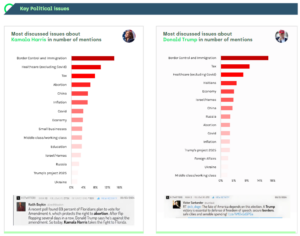
What differentiates Trump vs. Harris for issue importance and candidate stances:
- Border Control and Immigration: It’s by far the most talked-about issue and the favorite topic of Trump and his supporters on social media, ahead of healthcare and taxes. It is also the most divisive. Trump has promised a crackdown on immigration and the largest mass deportations of undocumented immigrants in US history. His campaign website says: ‘President Trump will end Biden’s border disaster’. Harris reiterates her support for the strict bipartisan border security agreement, which would have included hundreds of millions of dollars for the construction of a border wall. But this agreement was torpedoed by congressional Republicans earlier this year, at Trump’s instigation. The subject of immigration has also been boosted by Trump’s rumors about dog-eating Haitian migrants, to such an extent that this topic alone comes in 4th place.
- Abortion Rights: This is the issue on which Harris seems both the most comfortable and divergent from Joe Biden. Her message could be crucial in motivating voters. With Trump, this subject that he avoids, only appeared in 9ᵗʰ position: he has regularly stated that states should be free to decide their own abortion laws. But in recent weeks, he has tried to please everyone adopting a more moderate stance while trying not to alienate his conservative base. He criticized Florida’s six-week ban, but also said he would oppose a ballot measure in the state establishing abortion rights. Harris’s position, on the other hand, is clear: She wants to reinstate the protections that the Supreme Court removed, codifying the protections of Roe v. Wade.
- Small businesses: Unlike the RNC’s platform, the DNC’s draft platform and Kamala Harris addresses plans to support small business contracting and expansion opportunities.

Here we examine Owned media, i.e., the performance of candidates on their campaign social accounts during Q3: X (formally Twitter), TikTok, YouTube, Facebook, Instagram. We compare Trump and Harris and as well as their running mates. Note that Trump joined TikTok on June 2. He also returned to X(Twitter) on August 12 for a conversation with Elon Musk after a year’s inactivity since August 24, 2023.
Community
Donald Trump’s reappearance on X (currently 91.1M followers) has considerably boosted his community and impact. In fact, he also posts on Truth Social but is followed by “only” 7.78m subscribers, symptomatic of a network that operates in a closed circuit with right-wing and extreme right-wing communities only. It should be noted that during this one-year absence, the official @TrumpWarRoom X account has not ceased to publish in favor of Trump, averaging 480 posts per month.
Trump has the largest social media community, with nearly 170 million subscribers, far ahead of Harris (50.7M). This is mainly thanks to X, which accounts for 55% of his community, versus 42% for Harris. Trump’s strength lies in the dynamics of his social media accounts, which were very well followed during his term as president, in the spontaneity and frequency of his posts, and the type of messages, which are often highly polemical and polarizing, thus increasing his algorithmic visibility. Finally, he benefits from the support of the biggest account on X: Elon Musk ( 199M followers.)
Among the running mates, the balance is in favor of Tim Walz, who has a larger community than J.D. Vance (5.62 vs. 3.60M), well balanced between TikTok, Instagram, X and Facebook.

Interactions
TikTok now generates 79% of Trump’s social media interactions, compared with 63% for Harris: the VP has a strong second channel through Instagram (30% of her interactions are there, compared with 14% for Trump). Trump continues to generate a huge number of interactions for each of his posts (likes, shares, comments), but he publishes very frequently, which tends to reduce his average performance per post. The biggest difference between the candidates is on the Instagram channel: Harris achieves her best-performing posts in terms of engagement, on this channel, whereas Trump gathers likes and comments thanks to Tik Tok, often via minimalist videos (like his record-breaking Tik Tok post of Q3 all channels combined on August 6, where we see him dancing for 5 seconds, and that’s all).
As for running mates, J.D. Vance generates 9 times less engagement than Tim Walz. It has to be said that Vance doesn’t post much on social media, leaving the field open to Trump’s compulsive posts on X and Truth Social in particular. However, J.D. Vance’s rate of engagement per post is 2 times higher, thanks mainly to TikTok.
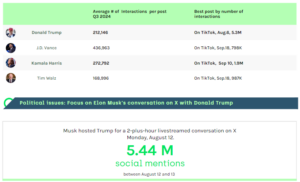
Key facts and figures
The X-event was delayed by nearly 45 minutes after the launch became mired in technical difficulties.
The public conversation between Trump and Musk lasted over two hours and was mostly friendly. The interview reached 1.3 million listeners at its peak. On social media, the conversation generated 5.44 million mentions between August 12 and 13. This represents a peak in the number of mentions of Donald Trump, but – logically – not as high as during his assassination attempt or the TV debate with Kamala Harris.
What are the possible impacts?
The personalities:
Musk: Beyond the conversation itself, the impact of this live talk show is linked to Elon Musk’s influence: Musk, who is not only the owner but also the most followed user on X (199.2 million followers in mid-September), has moved on to a more direct campaign of support for former President Donald Trump . Musk announced his official support for Trump in a post on 14 July that received 2.3 million likes. Since then, between July 15 and Sep. 23, Musk has published 50 tweets explicitly supporting Trump and 62 supporting Trump’s ideas or program or criticism of Harris/Democrats. Musk has also reinstated previously banned accounts, such as conspiracy theorist Alex Jones and Trump, who was kicked off the platform – then called Twitter – two days after the violence on 6 January. In terms of the electorate, young men who see Musk as a hero or business role model are a prime target for Trump, whose supporters tend to be older.
Trump: The interview marks Trump’s return to X after his account remained inactive for nearly a year. Indeed, the last time Trump posted on the social media site was when he posted his mug shot while incarcerated in an Atlanta jail as part of the Georgia election subversion case on August 24 last year. By the evening of the conversation, Trump had gained around 900,000 new followers since he started posting on the site again.
The most talked-about topics on social media
Trump spent time talking about his assassination attempt and illegal immigration, but also rehashed familiar campaign talking points. On social media, it was criticism of Kamala Harris’s abilities and illegal immigration that were relayed the most, mostly by Trump’s partners.
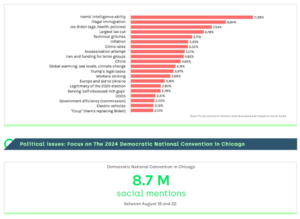
Key facts and figures
The Democratic National Convention was held August 19-22 in Chicago. The arrival of Kamala Haris on the campaign trail on July 21 considerably boosted interest in the DNC. In addition, the presence of some of the biggest names in the Democratic Party raised interest during the 4 nights of the convention.
VP Harris makes her mark: The convention ended with a powerful acceptance speech that highlighted the important issues at stake in the November 5 election. Of all the DNC speeches, this speech generated the most mentions on social media. Just a few weeks prior, the Democratic Party was in the throes of a heated debate over whether President Joe Biden should withdraw from the ticket, especially after a disastrous confrontation with Trump at the end of June during the CNN debate.
It’s newcomers and guests that make the DNC’s share of social media voice so much higher than the RNC’s share of voice in July: 8.7M mentions vs. 3.7 mentions.

Trump gives live commentary on speech: “Is She Talking About Me?”
After remaining relatively silent on Truth Social for most of the week, Trump unleashed a flood of not always coherent, real-time responses to Harris’s acceptance speech. He wrote more than 30 messages between the beginning and end of Harris’ 40-minute speech. Amid his somewhat out of context posts, including “WHERE’S HUNTER” and “IS SHE TALKING ABOUT ME?”, he has launched into a line of attack that may prove effective: asking why Harris hasn’t already kept her campaign promises during her term as vice president.
Timeline: the 4-day Democratic National Convention in Chicago, IL.
Here are the most discussed facts about the DNC on social media:
Day 1: “Thank you, Joe”
803K mentions: President’s keynote speech and Biden’s farewell
453K: Hillary Clinton slams Trump during DNC speech
155K: Democrats have criticized Donald Trump for nominating conservative justices to the Supreme Court, helping to undo the abortion rights protections of Roe v. Wade.
Day 2: “Yes, she can”
1.3M mentions: Michelle Obama’s speech : “Who’s going to tell him that the job he’s currently seeking might just be one of those ‘Black jobs’?”
1M: Barack Obama’s speech : “We all know that the sequel is usually worse”
186K: Harris and Walz at Milwaukee
118K: Doug Emhoff pulled back the curtain on their “blended family”
101K: DJ Cassidy stood onstage and performance from Georgia native Lil Jon
Day 3: “0ptimism over cynicism”
1.3M mentions: Walz introduces himself, and his family
420K: Oprah Winfrey stole the show
415K: Former President Bill Clinton said Harris brings “sheer joy” to the 2024 race
45K: Stevie Wonder performed “Higher Ground.”
Day 4: “America, we are not going back”
1.72M (including “We are not going back” mentions: 100K) : VP Kamala Harris delivers an acceptance speech that rallied Democrats around themes of patriotism — and portrayed Donald Trump as an enemy of classic American principles.

Key facts and figures
- The presidential debate was held on ABC News on Tuesday, September 10. VP Harris badgered Trump for most of the hour and 45 minutes of their first and potentially only debate while Trump tried to tie Harris to Biden. On practically every subject, Harris managed to annoy Trump.
- At the end of the debate, singer and pop icon Taylor Swift wrote in a lengthy post that she was backing the Kamala Harris ticket. She signed her message “Taylor Swift, Childless Cat Lady“ – a reference to running mate JD Vance’s controversial comments, which alienated many women. Her post has received over 10.7 M likes (as of Sept 13).
- Trump fans spread debate conspiracy about a “rigged” event and the fact Harris was being coached by using earphones embedded in her earrings.
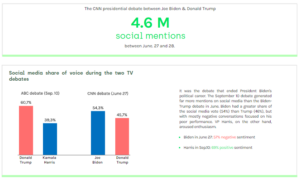
Most discussed topics about the presidential debate on ABC News
Three of the most commented topics concern fake news and conspiracy theories:
#1. Trump: “”In Springfield, they’re eating the dogs — the people that came in — they’re eating the cats. They’re eating — they’re eating the pets of the people that live there”
#4. False claims that VP Harris was wearing clip-on audio headphones disguised as beaded earrings circulated on social media after debate, promoted by prominent right-wing influencer accounts on X and other platforms.
#12. “Are you now acknowledging that you lost in 2020?” ABC News moderator David Muir asked. “No, I don’t acknowledge that at all,” Trump said.
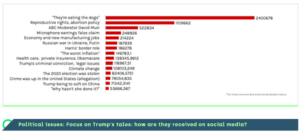
Key facts and figures
- Trump’s distance from reality and facts is nothing new. During and after his term as President of the United States, Donald Trump has made thousands of false or misleading claims. The Washington Post’s fact-checkers counted 30,573 false or misleading claims during his presidential term, averaging about 21 per day.
- It started early, on the day after his inauguration, in January 2017, when he falsely accused the media of lying about the size of the crowd. He then exaggerated the size. The obsession with crowd size was raised again during the September 10, 2024 debate with Kamala Harris.
- More recently, during a 64-minute Trump press conference at his Mar-a-Lago estate in Florida on August 8, NPR counted more than 162 “inaccuracies, exaggerations and outright lies”, an average of more than two per minute.
- Now, fact-checking of Trump’s comments is systematic. This allows them to be relayed on social media. This was the case during the September 10 debate, when ABC News fact-checkers found that Trump made many false claims (over 30), while Harris made one false and several misleading statements according to CNN’s count. But this remains a tense exercise, as it requires a perfect balance of treatment between the different political currents and a precise qualification between inaccuracies or outright lies.
- The debunking of rumors and tales by the media has a significant impact when it is taken up by social media with a high degree of propagation. This is the case, for example, of the “eating dogs” rumor.
Trump’s biggest tales (in terms of duration and volume on social media)

While blaming immigrants for eating pets is an old American urban legend, this new version has emerged.
- Origin: August (from far-right communities on Telegram)
- September 5: a post from an Ohio woman on a Facebook group goes viral.
- Sep. 9: Amplification by JD Vance on X: 163K interactions (like, repost and comments)
- Sep. 10: Hyper-amplification by Trump at ABC News debate.
- Sep. 12: Springfield officials deny rumors. Many Memes and videos mocking Trump appear on social media
- Sept. 12 and 13: On Thursday, Springfield City Hall was evacuated following bomb threats, and several schools in the area had to close following similar threats on Friday.
- Spread on social media: very strong. Fake news still circulating: >30%

- Origin: January 30, 2019: Former Virginia governor Ralph Northam, Democrat and pediatric neurologist, clarifies in an interview about a proposed bill: ”abortions in the third trimester of pregnancy would be performed in cases where there may be severe malformations, or a nonviable fetus“. This bill was never passed. Abortion is currently legal in Virginia up to the third trimester.
- Five years later, Trump seems to cite this interview as evidence of what he calls the Democrats’ “radical” stance on abortion access.
- April 8, 2024: On his Truth Social network, Donald Trump falsely claims that Democrats support abortion “up to and beyond the ninth month”, suggesting that this includes “executing” babies after birth.
- June 27: At the CNN debate, Trump falsely claims that Democrats want to allow the execution of babies after birth.
- September 10: At the ABC News debate, Trump falsely claims that some states allow the execution of babies, in addition to allowing abortion in the ninth month.
- Social media coverage: average. Fake news still circulating: >25%

Key facts and figures
Starting from scratch, the Harris-Walz campaign excited crowds at rallies and generated strong spikes in mentions on social media, with peaks at the Biden endorsement of Kamala Harris to become the Democratic Presidential candidate and at the September 10 ABC News debate.

Analysis of mentions clearly shows a boost in mentions of Harris from July 22 onwards, now outstripping the already voluminous mentions of Donald Trump (note two spikes in mentions of the latter on July 13 and September 15 during his assassination attempts).
Which moments in the Harris-Walz campaign generated the most positive mentions?
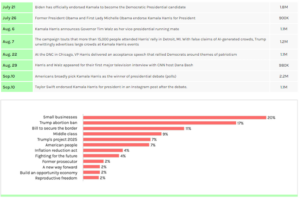
October U.S. Election Report events
